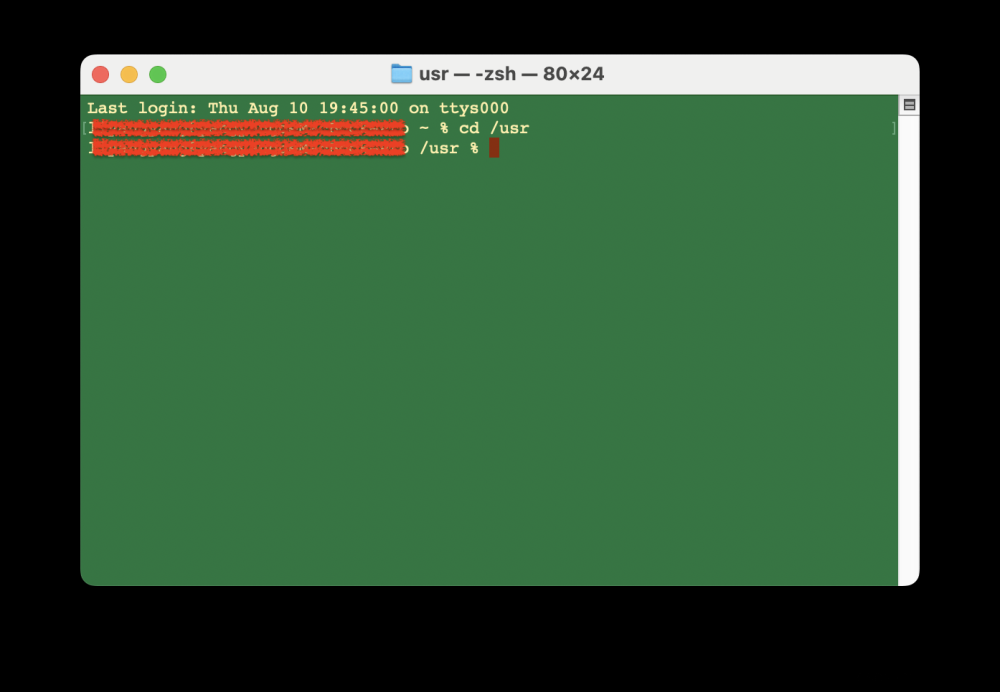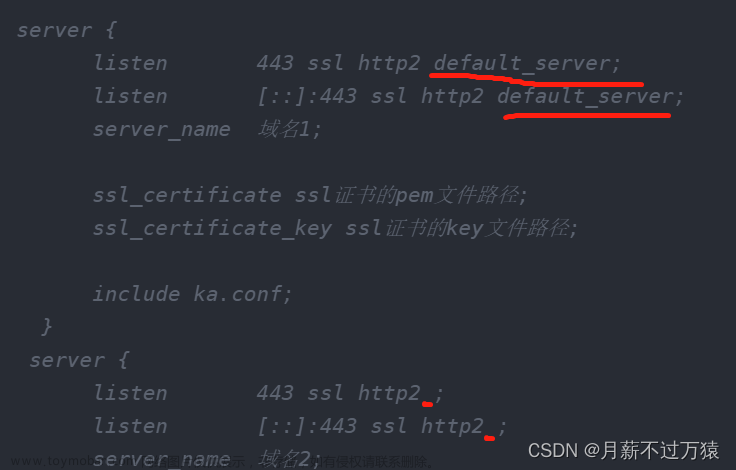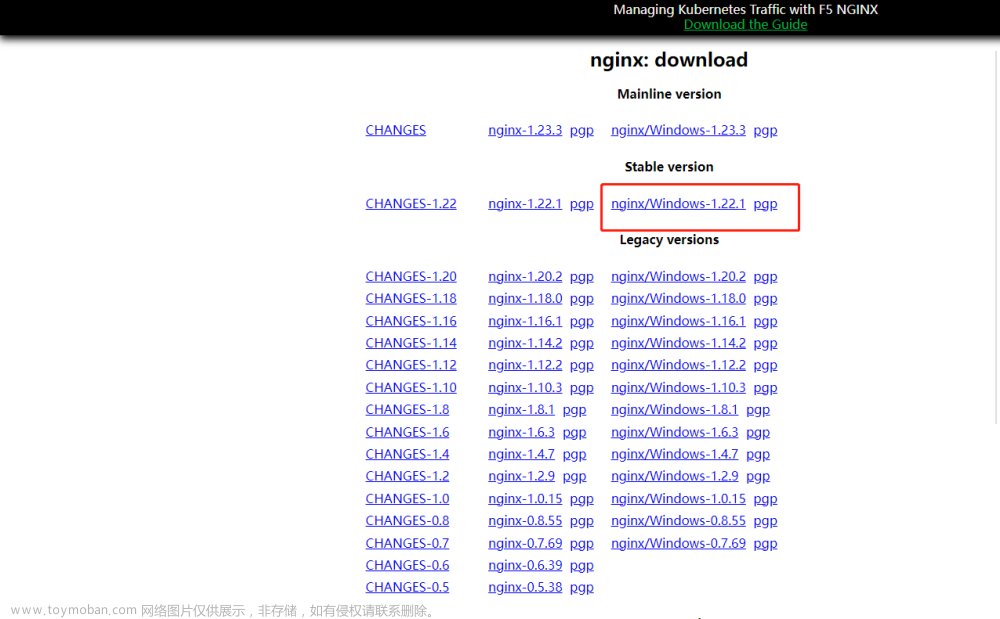Nginx的主配置文件是nginx.conf,这个配置文件一共由三部分组成,分别为全局块、events块和http块。
在http块中,又包含http全局块、多个server块。每个server块中,可以包含server全局块和多个location块。在同一配置块中嵌套的配置块,各个之间不存在次序关系。
一、默认配置文件
#user nobody;
worker_processes 1;
#error_log logs/error.log;
#error_log logs/error.log notice;
#error_log logs/error.log info;
#pid logs/nginx.pid;
events {
worker_connections 1024;
}
http {
include mime.types;
default_type application/octet-stream;
#log_format main '$remote_addr - $remote_user [$time_local] "$request" '
# '$status $body_bytes_sent "$http_referer" '
# '"$http_user_agent" "$http_x_forwarded_for"';
#access_log logs/access.log main;
sendfile on;
#tcp_nopush on;
#keepalive_timeout 0;
keepalive_timeout 65;
#gzip on;
server {
listen 80;
server_name localhost;
#charset koi8-r;
#access_log logs/host.access.log main;
location / {
root html;
index index.html index.htm;
}
#error_page 404 /404.html;
# redirect server error pages to the static page /50x.html
#
error_page 500 502 503 504 /50x.html;
location = /50x.html {
root html;
}
# proxy the PHP scripts to Apache listening on 127.0.0.1:80
#
#location ~ \.php$ {
# proxy_pass http://127.0.0.1;
#}
# pass the PHP scripts to FastCGI server listening on 127.0.0.1:9000
#
#location ~ \.php$ {
# root html;
# fastcgi_pass 127.0.0.1:9000;
# fastcgi_index index.php;
# fastcgi_param SCRIPT_FILENAME /scripts$fastcgi_script_name;
# include fastcgi_params;
#}
# deny access to .htaccess files, if Apache's document root
# concurs with nginx's one
#
#location ~ /\.ht {
# deny all;
#}
}
# another virtual host using mix of IP-, name-, and port-based configuration
#
#server {
# listen 8000;
# listen somename:8080;
# server_name somename alias another.alias;
# location / {
# root html;
# index index.html index.htm;
# }
#}
# HTTPS server
#
#server {
# listen 443 ssl;
# server_name localhost;
# ssl_certificate cert.pem;
# ssl_certificate_key cert.key;
# ssl_session_cache shared:SSL:1m;
# ssl_session_timeout 5m;
# ssl_ciphers HIGH:!aNULL:!MD5;
# ssl_prefer_server_ciphers on;
# location / {
# root html;
# index index.html index.htm;
# }
#}
}
二、结构说明
... #全局块
events { #events块
...
}
http #http块
{
... #http全局块
server #server块
{
... #server全局块
location [PATTERN] #location块
{
...
}
location [PATTERN]
{
...
}
}
server
{
...
}
... #http全局块
}
1、全局块:配置影响nginx全局的指令。一般有运行nginx服务器的用户组,nginx进程pid存放路径,日志存放路径,配置文件引入,允许生成worker process数等。
2、events块:配置影响nginx服务器或与用户的网络连接。有每个进程的最大连接数,选取哪种事件驱动模型处理连接请求,是否允许同时接受多个网路连接,开启多个网络连接序列化等。
3、http块:可以嵌套多个server,配置代理,缓存,日志定义等绝大多数功能和第三方模块的配置。如文件引入,mime-type定义,日志自定义,是否使用sendfile传输文件,连接超时时间,单连接请求数等。
4、server块:配置虚拟主机的相关参数,一个http中可以有多个server。
5、location块:配置请求的路由,以及各种页面的处理情况。
三、配置说明
########### 每个指令必须有分号结束。#################
#配置用户或者组,默认为nobody nobody,以什么用户启动 nginx程序,涉及到文件的读写权限,一般应该用root。
user root;
#允许生成的进程数,默认为1。标配一个cpu起一个进程。
worker_processes auto;
#指定nginx进程运行文件存放地址
pid /nginx/pid/nginx.pid;
#制定日志路径,级别。这个设置可以放入全局块,http块,server块,级别以此为:debug|info|notice|warn|error|crit|alert|emerg
#error_log log/error.log debug;
events {
#设置网路连接序列化,防止惊群现象发生,默认为on
#accept_mutex on;
#设置一个进程是否同时接受多个网络连接,默认为off
#multi_accept on;
#事件驱动模型,select|poll|kqueue|epoll|resig|/dev/poll|eventport
#use epoll;
#最大连接数,可以根据实际情况扩大,生产可扩大到10240
worker_connections 10240;
}
http {
#文件扩展名与文件类型映射表
include mime.types;
#默认文件类型,默认为text/plain
default_type application/octet-stream;
#取消服务日志
#access_log off;
#自定义格式
#log_format myFormat '$remote_addr–$remote_user [$time_local] $request $status $body_bytes_sent $http_referer $http_user_agent $http_x_forwarded_for';
#combined为日志格式的默认值
#access_log log/access.log myFormat;
#允许sendfile方式传输文件,默认为off,可以在http块,server块,location块。
sendfile on;
#每个进程每次调用传输数量不能大于设定的值,默认为0,即不设上限。
sendfile_max_chunk 100k;
#连接超时时间,默认为75s,可以在http,server,location块。
keepalive_timeout 75;
#接收客户端请求体超时
client_body_timeout 20s;
#客户端连接nginx超时, 建议5s内,接收客户端header超时时间,超时返回408
client_header_timeout 10s;
#限制请求体的大小,若超过所设定的大小,返回413错误。
client_max_body_size 10M;
#Nginx分配给请求数据的Buffer大小,如果请求的数据小于client_body_buffer_size直接将数据先在内存中存储。
#大于该值小于client_max_body_size,就会将数据先存储到临时文件(用户组要有读写权限)中,client_body_temp 指定的路径中,默认该路径值是/tmp/。
client_body_buffer_size 128k;
#开启自定义错误重定向,不存在会返回404页面
fastcgi_intercept_errors on;
#热备
upstream mysvr {
server 127.0.0.1:7878;
server 192.168.10.121:3333 backup;
}
server {
#单连接请求上限次数。
keepalive_requests 120;
#监听端口
listen 4545;
#监听地址
server_name 127.0.0.1;
#请求的url过滤,正则匹配,~为区分大小写,~*为不区分大小写。
location ~*^.+$ {
#根目录,设置目录
#root path;
#设置默认页
#index index.htm;
#请求转向mysvr 定义的服务器列表
proxy_pass http://mysvr;
#拒绝的ip
#deny 127.0.0.1;
#允许的ip
#allow 172.18.5.54;
}
}
}
四、常用案例
案例1:页面转发,80端口指向index,前后台可用
server {
listen 80;
server_name localhost;
location / {
root /home/user01/dist/;
try_files $uri $uri/ /index.html;
index index.html index.htm;
}
案例2:接口转发。80/api指向后台服务端口
server {
location /api/{
proxy_set_header Host $http_host;
proxy_set_header X-Real-IP $remote_addr;
proxy_set_header REMOTE-HOST $remote_addr;
proxy_set_header X-Forwarded-For $proxy_add_x_forwarded_for;
proxy_pass http://localhost:48080/;
}
}
案例3:文件路径转发。80/uploadFile指向文件路径
server {
location /uploadFile/{
proxy_pass http://localhost:48081/;
}
}
server {
listen 48081;
server_name localhost;
charset utf-8;
root /home/user01/java/file;
location / {
autoindex on;
autoindex_exact_size off;
autoindex_localtime on;
}
}
简略配置:
location /uploadFile{
root /home/user01/java/file;
}
案例4::端口转发,将本地端口指向其他地址
server {
listen 127.0.0.1:8279;
location / {
proxy_pass http://ip:8279;
}
}
案例5:负载均衡,将一个端口指向多个服务
server {
listen 8888;
location / {
#通过代理将请求发送给 upstream 命名的HTTP 服务
proxy_pass http://myserver;
}
}
#定义一个 HTTP 服务组
upstream myserver{
#用server定义HTTP 地址。后面不写默认轮询。
server 127.0.0.1:8080 max_fails=5 fail_timeout=10s weight=10;
server 127.0.0.1:8081 backup;
server 127.0.0.1:8082 down;
}
upstream myserver{
#相同的客户端ip请求相同的服务器。
server 127.0.0.1:8080;
server 127.0.0.1:8081;
ip_hash;
}
- weight,加权轮询。
- down,表示当前的server暂时不参与负载均衡。
- backup,预留的备份机器。当其他所有的非backup机器出现故障或者忙的时候,才会请求backup机器,因此这台机器的压力最轻。
- max_fails,允许请求失败的次数,默认为1。当超过最大次数时,返回proxy_next_upstream 模块定义的错误。
- fail_timeout,在经历了max_fails次失败后,暂停服务的时间。max_fails可以和fail_timeout一起使用。
五、配置文件新增端口转发配置技巧
1、在nginx.conf中http加入一行include tcpconf/*.conf;文章来源:https://www.toymoban.com/news/detail-786733.html
http {
include tcpconf/*.conf;
}
2、在nginx.conf目录下,新建文件夹tcpconf,其他配置文件命名.conf,文件中写入转发的配置。例如下面,然后重启生效。文章来源地址https://www.toymoban.com/news/detail-786733.html
server {
listen 127.0.0.1:8279;
location / {
proxy_pass http://ip:8279;
}
}
到了这里,关于nginx conf配置篇,如何配置.conf文件的文章就介绍完了。如果您还想了解更多内容,请在右上角搜索TOY模板网以前的文章或继续浏览下面的相关文章,希望大家以后多多支持TOY模板网!













